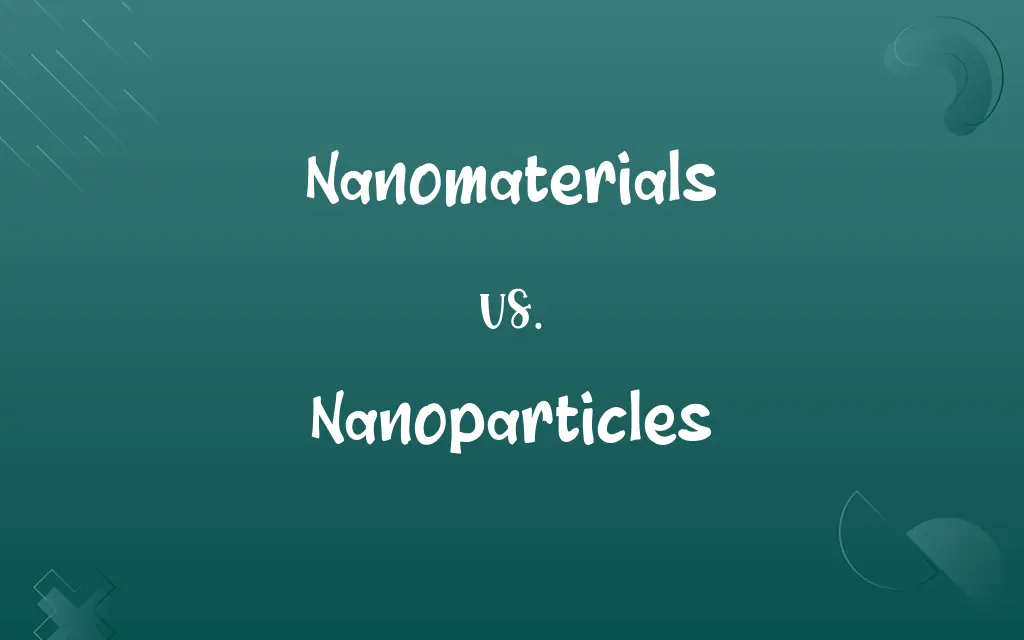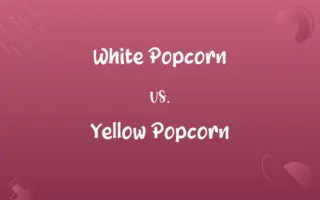Nanomaterials vs. Nanoparticles: Know the Difference

By Shumaila Saeed || Updated on December 25, 2023
Nanomaterials are diverse materials with components smaller than 100nm, whereas nanoparticles are specific, ultrafine particles within this size range.

Key Differences
Nanomaterials refer to a broad category of materials characterized by their ultra-small features, typically below 100 nanometers (nm) in at least one dimension. Nanoparticles, on the other hand, are a specific subset of nanomaterials that are particles in the nano-size range, usually spherical or near-spherical in shape. Both are significant in advanced technology fields due to their unique properties.
Shumaila Saeed
Dec 16, 2023
The unique aspect of nanomaterials lies in their vastly increased surface area to volume ratio compared to bulk materials, which often leads to novel physical, chemical, and biological properties. Nanoparticles exhibit these effects distinctly, as their entire structure is within the nanoscale, influencing their reactivity and interactions with other materials. Both are essential in sectors like medicine, electronics, and environmental science.
Shumaila Saeed
Dec 16, 2023
Nanomaterials can include a variety of structures such as nanotubes, nanowires, and quantum dots, each with specific applications. Nanoparticles are often used more narrowly in contexts like drug delivery systems, catalysts, or as components of composite materials. The study and application of both are crucial in nanotechnology.
Shumaila Saeed
Dec 16, 2023
In production, nanomaterials are synthesized through methods like chemical vapor deposition or mechanical milling, tailored to their intended structure and use. Nanoparticles are often produced through methods like sol-gel processes or ball milling, focusing on achieving precise size and shape control. Understanding the distinctions between these two is vital for researchers in the field.
Shumaila Saeed
Dec 16, 2023
Nanomaterials encompass a wide range of materials, and their safety and environmental impact are topics of ongoing research. Nanoparticles, due to their small size and high reactivity, pose specific concerns in terms of toxicity and environmental accumulation, necessitating careful study and regulation. Both represent a frontier in material science with profound implications.
Shumaila Saeed
Dec 16, 2023
ADVERTISEMENT
Comparison Chart
Definition
Broad category of materials with nano-sized features
Specific ultrafine particles in the nanoscale range
Shumaila Saeed
Dec 16, 2023
Shape and Structure
Includes various shapes like tubes, wires, films
Often spherical or near-spherical in shape
Shumaila Saeed
Dec 16, 2023
Production Methods
Methods like chemical vapor deposition, mechanical milling
Techniques like sol-gel process, ball milling
Shumaila Saeed
Dec 16, 2023
Applications
Broad, including electronics, medicine, coatings
Specific, like drug delivery, catalysts, sensors
Shumaila Saeed
Dec 16, 2023
Research Focus
General properties, applications in various fields
Specific interactions, toxicity, environmental impact
Shumaila Saeed
Dec 16, 2023
ADVERTISEMENT
Nanomaterials and Nanoparticles Definitions
Nanomaterials
Materials with structural components smaller than 100 nanometers.
Nanomaterials are revolutionizing the medical field with their ability to target diseases at a molecular level.
Shumaila Saeed
Dec 11, 2023
Nanoparticles
Tiny particles that exhibit unique properties due to their small size.
Nanoparticles in sunscreens provide better UV protection with less visible residue.
Shumaila Saeed
Dec 11, 2023
Nanomaterials
Ultra-small materials that exhibit novel behavior due to their size.
Nanomaterials are being used to create ultra-lightweight and strong materials for aerospace applications.
Shumaila Saeed
Dec 11, 2023
Nanoparticles
Particles at the nanoscale, often used in targeted applications like medicine.
Magnetic nanoparticles are used in MRI contrast agents for enhanced imaging.
Shumaila Saeed
Dec 11, 2023
Nanomaterials
A broad category of nano-sized materials with unique physical and chemical properties.
The unique properties of nanomaterials make them ideal for creating more efficient solar panels.
Shumaila Saeed
Dec 11, 2023
ADVERTISEMENT
Nanoparticles
Ultrafine particles with dimensions between 1 and 100 nanometers.
Nanoparticles are used in drug delivery to target cancer cells more effectively.
Shumaila Saeed
Dec 11, 2023
Nanomaterials
Advanced materials engineered at the nanoscale for specific applications.
Nanomaterials are integral in developing high-capacity batteries for electric vehicles.
Shumaila Saeed
Dec 11, 2023
Nanoparticles
Small particles engineered for specific reactions and interactions.
Nanoparticles are being developed to improve the efficiency of photocatalysts.
Shumaila Saeed
Dec 11, 2023
Nanomaterials
Materials whose nanostructure influences their macroscopic properties.
Nanomaterials have opened new possibilities in the field of nanoelectronics and photonics.
Shumaila Saeed
Dec 11, 2023
Nanoparticles
Sub-microscopic particles with new or enhanced size-dependent qualities.
Nanoparticles in paints lead to more durable and vibrant colors.
Shumaila Saeed
Dec 11, 2023
Repeatedly Asked Queries
What makes nanoparticles unique?
Nanoparticles have unique properties due to their small size and high surface area.
Shumaila Saeed
Dec 16, 2023
What are nanomaterials?
Nanomaterials are materials with structural features smaller than 100 nanometers.
Shumaila Saeed
Dec 16, 2023
Can nanomaterials be toxic?
Some nanomaterials may be toxic, depending on their composition and use.
Shumaila Saeed
Dec 16, 2023
How are nanomaterials synthesized?
Nanomaterials are synthesized using methods like chemical vapor deposition.
Shumaila Saeed
Dec 16, 2023
What is a common method to produce nanoparticles?
A common method is the sol-gel process.
Shumaila Saeed
Dec 16, 2023
Do nanomaterials affect the environment?
The environmental impact of nanomaterials is an area of active research.
Shumaila Saeed
Dec 16, 2023
How are nanomaterials used?
Nanomaterials are used in various fields like electronics, medicine, and environmental science.
Shumaila Saeed
Dec 16, 2023
What are nanoparticles?
Nanoparticles are specific, ultrafine particles in the nanoscale range.
Shumaila Saeed
Dec 16, 2023
Are nanoparticles found in consumer products?
Yes, nanoparticles are used in products like sunscreens, paints, and electronics.
Shumaila Saeed
Dec 16, 2023
Are nanoparticles used in energy storage?
Yes, nanoparticles are used in batteries and supercapacitors.
Shumaila Saeed
Dec 16, 2023
Do nanoparticles have optical properties?
Yes, nanoparticles can have unique optical properties like fluorescence.
Shumaila Saeed
Dec 16, 2023
Can nanoparticles enter the human body?
Yes, nanoparticles can enter the body through inhalation, ingestion, or skin contact.
Shumaila Saeed
Dec 16, 2023
What is the size range of nanomaterials?
Nanomaterials have features below 100 nanometers.
Shumaila Saeed
Dec 16, 2023
How do nanoparticles interact with cells?
Nanoparticles can interact with cells at a molecular level, affecting cellular processes.
Shumaila Saeed
Dec 16, 2023
Can nanomaterials be biodegradable?
Some nanomaterials are designed to be biodegradable.
Shumaila Saeed
Dec 16, 2023
Are nanoparticles always spherical?
Most nanoparticles are spherical, but they can have other shapes.
Shumaila Saeed
Dec 16, 2023
What are the applications of nanomaterials in medicine?
Nanomaterials are used in drug delivery, imaging, and diagnostics.
Shumaila Saeed
Dec 16, 2023
Can nanomaterials conduct electricity?
Some nanomaterials, like carbon nanotubes, are excellent conductors.
Shumaila Saeed
Dec 16, 2023
Are nanoparticles magnetic?
Some nanoparticles, like iron oxides, are magnetic and used in magnetic applications.
Shumaila Saeed
Dec 16, 2023
What are the safety concerns with nanomaterials?
Safety concerns include toxicity, exposure routes, and long-term effects.
Shumaila Saeed
Dec 16, 2023
Share this page
Link for your blog / website
HTML
Link to share via messenger
About Author
Written by
Shumaila SaeedShumaila Saeed, an expert content creator with 6 years of experience, specializes in distilling complex topics into easily digestible comparisons, shining a light on the nuances that both inform and educate readers with clarity and accuracy.



































































